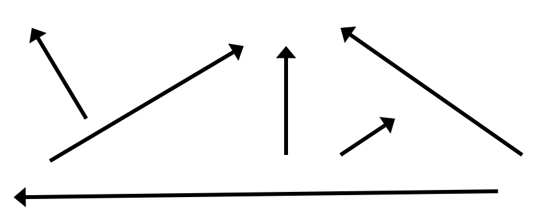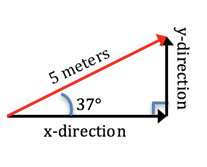This article is the third chapter in a series on how to understand and approach kinematics problems. The first chapter covered position, velocity, and acceleration. The second chapter covered solving kinematics in one dimension Now we are going to take a quick detour into vectorland so that we’re ready to approach kinematics in two (and even three) dimensions.
What is a Vector?
There are plenty of ways to think about vectors, but the basic definition is a magnitude (number) and a direction. So “four meters east” is just a vector in word form. You can also think of a vector as an arrow; it points a certain distance in a certain direction.

All of these are vectors, and beautiful vectors at that.
Adding Vectors
Adding vectors doesn’t work quite the same as adding numbers. We can’t just sum the magnitudes (this is a common mistake) because that doesn’t account for the direction. After all, if you walked 8 meters east and then 5 meters west, you wouldn’t be 13 meters away from where you started; you’d be only 3 (we saw a version of this idea in Chapter 1’s discussion of displacement)
When adding vectors, instead of summing the magnitudes, we stick one on the end of the other and seeing where they end up.
So if I want to add this vector  to this vector
to this vector 
I can stick them together to get:

We call the red vector the “resultant” because it is the vector that results from adding the two vectors together
Vector Components
To clarify vectors, we often write them as the sum of their “components.” Each component tells how far the vectors goes in a particular direction. Usually, the agreed on set of directions is x̂, ŷ, ẑ. Physics books sometimes call these directions î, ĵ, k̂ because they are dumb (actually it is to simplify vector fields when things get more advanced).
Why does this work? Vector addition! Since vectors add, we can think of every vector as the sum of 2 (in 2-D) or 3 (in 3-D) vectors that only move in the x, y, or z directions.

Writing Out Components
There are a lot of ways to write out components. The most common are:
(5, 6, 7)
5x̂ + 6ŷ + 7ẑ
5î + 6ĵ + 7k̂
Note: the little hat ^ signifies a unit vector, which is just a vector that points in a particular direction (for example x̂ points in the x direction) and has a length of one. By multiplying that unit vector by a number, you create a longer vector in that same direction.
Finding the Components of a Vector
Say you get a vector with a specific magnitude and an angle from the horizontal (also known as the x-axis) and you want to find the component vectors. This is very common in kinematics and beyond, but how do you do it? The answer is the same as the key to any successful folk-rock band: proper use of triangles.
Remember when we divided our vector into components? You might have noticed that the components and original vector formed a right triangle. This is because the x- and y-axes are always 90° from each other by definition. You might also remember from geometry that if we have an angle and hypotenuse for a right triangle, then we can find the other sides (called legs) by using SOH-CAH-TOA.
A brief review of SOH-CAH-TOA
You can find more in-depth reviews online, but the basic idea of SOH-CAH-TOA is that the sine of an angle is equal to the side opposite the angle divided by the hypotenuse (thus S=O/H or SOH). Likewise, the cosine equals the adjacent side over the hypotenuse (C=A/H) and the tangent equals the opposite side over the adjacent side (T=O/A). Using this, it’s easy to prove that the vertical leg, the y-direction, of our component triangle is going to be hypotenuse*sin(angle). Or, since the hypotenuse is our original vector, vector magnitude*sin(angle). Likewise, the x-direction will be just vector magnitude*cos(angle).
Example: Finding the Components of a Vector
I have a vector of magnitude of 5 meters that points up and right at an angle of 37 degrees from the x-axis. I want to know the component form. Let’s work through it.
Steps:
- Draw the vector.

- Add in the triangle legs.

- Math
y-direction = magnitude * sin(angle) = 5 meters * sin (37) = 3 meters
x-direction = magnitude * cos(angle) = 5 meters * cos (37) = 4 meters - Plug the solutions into the definition of a vector
Vector = 3x̂ + 4ŷ
Tada, easy as π!
Finding Magnitude and Direction with Components
Sometimes you might be given the components of a vector and want to find the overall magnitude and angular direction of that vector. Again, it’s triangles to the rescue.
The magnitude of a vector is easy to calculate with Pythagorean theorem. From Pythagorean theorem, a2+b2=c2, so when we apply that to the vectors:
(vector magnitude)2=(x-component) 2+(y-component) 2.
To find the angular direction of a vector, we can use an inverse tangent. Since tangent equals the opposite side over the adjacent side (T=O/A):
tan(angle of the vector)=(y-component)/(x-component)
Then use the invtan function on your calculator to find the inverse of that tangent, which gives you the angle.
Adding Vectors with Components
The best part about vector components is that they make adding vectors easy. As long as we keep our x, y, and z components distinct, we can just add the components. Thus, if V1=(x1, y1, z1) and V2 = (x2, y2, z2) then the vector the sum of them is V1+V2=(x1+x2, y1+y2, z1+z2). Once you have this new vector, you can use the previous section to find the magnitude and angular direction.
Conclusion
We now know what a vector is, how to divide it into components, how to add these components and how to recombine it into magnitude and angle. In our next blog, we’ll discuss how to use these vectors for kinematics in two dimensions.
Comments